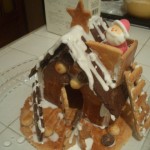 This year, I purchased and brought back a couple Muji 「 クリスマスへクセンハウス」 (no idea what “へクセン” might be, but I’m sure it’s delicious*) for everybody to enjoy… As it turns out, my dear little brothers out there in Canada had a hard time reading cooking instructions (sure: they’re written in Japanese. so what). Here is therefore the detailed recount of my own attempt at building a biscuit house, for their sake and yours.
This year, I purchased and brought back a couple Muji 「 クリスマスへクセンハウス」 (no idea what “へクセン” might be, but I’m sure it’s delicious*) for everybody to enjoy… As it turns out, my dear little brothers out there in Canada had a hard time reading cooking instructions (sure: they’re written in Japanese. so what). Here is therefore the detailed recount of my own attempt at building a biscuit house, for their sake and yours.
Should you attempt to follow, it will help if you have the same awesome Muji kit handy, but an inventive and resourceful person could do without (none of the ingredients are that hard to find, and the schematics can probably be figured out from scratch with limited engineering skills). Also, this is not a completely faithful translation of the original instructions: I have added a couple personal touches as well as skipped the more obvious advices (be careful with the knife, do not stick your tongue in the oven etc.).
Anyway, off we go:
Ingredients
In the kit:
- cocoa powder(ココアパウダ): 10g
- cookie mix (クッキーミックス): 400g
- powdered sugar(粉糖): 100g
Additionally you’ll need:
- butter (or margarine): 80g
- 2 eggs: 1 full, 1 with white and yolk separated.
- sugar: 150g
- milk: 60ml
Instructions:
- Melt the butter (by staring intensely at it, using telekinetic powers. failing that: your microwave on 500W).
- Set aside a large spoonful of it and mix it with the cocoa powder.
- Mix the rest of the butter with the sugar and whisk until it reaches a noticeably whiter shade.
- Pour in the cookie mix, milk and full egg and mix the lot. Knead into a dough.
- Set aside 1/4 of the dough you just made in 4) and mix it with the cocoa paste you made in 2). You now have two balls of dough: one big plain, one small chocolate-flavoured.
- Spread the dough into a 4mm (not three, not five: four mm) layer. Use rolling pin and flour as you see fit.
- Let the dough rest for about 20 mins while pre-heating the oven at 170° C
- Using the conveniently provided schematics (or making up your own), cut out all shapes required by your engineering project and dispose on the oven shelf.
- Spread a thin layer of egg yolk on each part with a cooking brush. Now is also a good time to carve some patterns (bricks for the walls etc.)
- Put in the oven: remove after about 13mins, when it reaches a nice biscuit-like consistency.
- Beat the egg white (use a few drops of lemon juice) and mix it to the powdered sugar: there’s your icing! That thing will glue absolutely anything together.
- Using the helpfully provided pastry bag and the icing you made in 11), glue all the pieces of your house together.
- Some more icing for a snowy roof, a little pine tree here, some bushes there…. You’re done.
- If you are lucky, yours might look half as cool as ours.
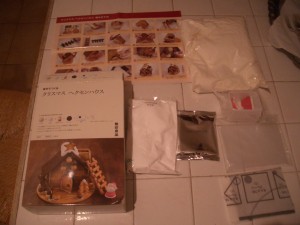
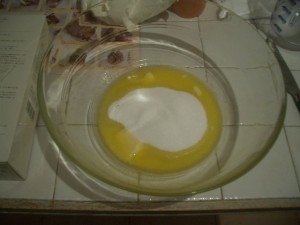

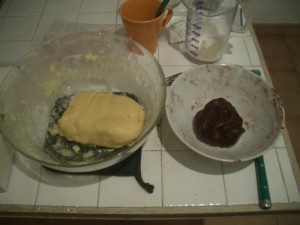
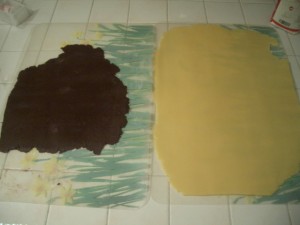
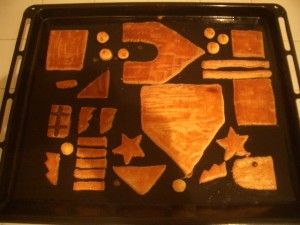
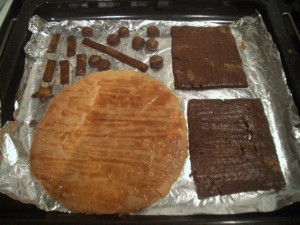
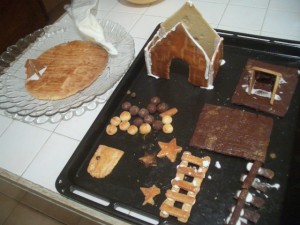
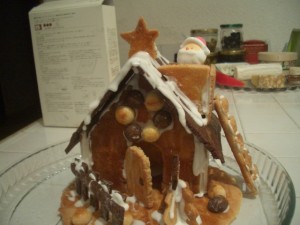

ok, let me help you with that one.
Hexenhaus is German. As is the fairy tale by the Grimm brothers (which is mentioned on the MUJI webpage, btw). As far as I know, it has nothing to do with Christmas but it might sell better nowadays. If you’re interested in the tale, it is available here http://www.gutenberg.org/ebooks/2591
There’s also an opera by Humperndinck on this beautiful story.
Haensel and Gretel, the two main characters, get lost and they find a Hexenhaus (Hexe means old witch, you already got the Haus right) and as the house is made of sweets, Haensel and Gretel start eating it. Dangerous dangerous…
Btw, congrats on your baking skills 😉
@Christian: Ah! So that’s what it is!
I read the description over on the Muji page and of course, I read the original Grimm tale as a kid, but having never read it in its original language, I had no idea about the German name for it (and somehow never heard of the word Hexe in German: probably too many classes on the Berlin wall, not enough on witches). Thanks for this update!
It really didn’t take much skills other that following faithfully the instructions, really.
Hope you’re having a happy holidays!